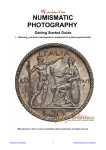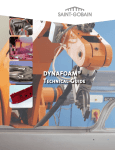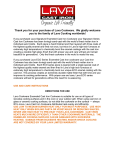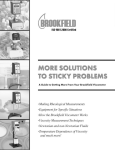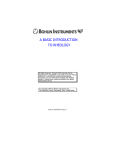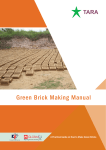Download Two-component material Weighing and mixing Processing time
Transcript
Acrylic One is a water based resin system. Acrylic One is suitable for making pieces of art & art objects, panels, facade ornaments and frames, moulds, supporting moulds, decorations, design furniture and more. Acrylic One’s special composition makes it easy to use, environmentally friendly and fire resistant. Acrylic One can take on any shape or form. Which means it is suitable for making manually formed shapes and enables an artist or architect to produce “One of a kind” products. Acrylic One is also very suitable for making product ranges, by using casting or laminating in any desired quantity. Acrylic One looks like ivory stone without additives or colorants and is as hard as composite. Read more about how to work with Acrylic One and which additives and fillers are available in this user manual. Processing time Acrylic One is a two-component material and consists of a mineral powder and a water based acrylic resin. These bond and result in a very strong material. Acrylic One is environmentally friendly, non toxic, fire resistant and is easy to use. The standard processing time after mixing is 20 minutes. When a shorter or longer processing time is required, this can be achieved by adding additives. Important areas of application • Architecture, indoor as well as outdoor • Decorations and stage-setting • Laminated panels • Reproductions • Moulding • Model building • Moulding constructions and supporting moulds • Covering polystyrene Acrylic One is a water based product. Residual moisture must evaporate before obtaining the final result. The time needed for curing strongly depends on external factors, such as the dimension of the object, the temperature and humidity. When the object has been laminated or cast in a mould, it can be removed from the mould as soon as it is strong enough to cope with the forces present. The product will achieve the optimum strength outside of the mould. Properties • Solvents free • Low generation of heat (max 40°C) • No shrinkage • Environmentally friendly • Better working conditions • Very high standard of fire resistance • UV stabilized • Can be painted over • Great variety in surface structures • Rain water proof (when sealed) • Good mechanical properties Acrylic One can be casted, laminated, applied with spatula, brushed or rolled. These techniques can be used in combination and can be applied in a mould or on an object. Technical data Mixing ratio Two-component material Colour Density (wet) Density (dry) Processing time Demoulding time Shelf life 2 parts powder 1 part acrylic resin creamy white *1 1.75 kg / dm3 1.66 kg / dm3 20 minutes approx. 1 hour 1 year *2 Hardness Expansion during hardening Compression strength LOP (limit of proportionality) MOR (modulus of rupture) 85º Shore D < 0.1 % approx. 30 MPa approx. 20 MPa approx. 60 MPa Weighing and mixing Acrylic One must be carefully weighed and mixed. The mixing ratio of Acrylic One is 2 parts powder mixed with 1 part resin. Fill the beaker or bucket with the required amount of resin. Use the stainless steel High Shear Mixer to create a swirl. Then add the correct amount of powder into the swirl. Continue mixing until a smooth mixture is achieved without lumps and continue to mix for an additional 30 seconds approx. Ensure that none of the material sticks to the bottom and sides and that everything is included in the mixture. Maintain a maximum number speed of 750 rpm when mixing with the High Shear Mixer. Curing time Gel coat A gel coat is often used when working with Acrylic One. This gel coat can be applied as follows: • Add the Acrylic One resin pigment in the desired colour, if needed. • Then Mix the Acrylic One resin in with the powder until a smooth mixture is obtained. • Add the desired amount of Acrylic One Thix A to the mixture, by adding it in drops until the desired viscosity is achieved. Never exceed the maximum amounts. • Apply the gel coat layer in the mould of at least 1 mm layer thickness, with a brush. • After the gel coat has set, which takes 20 minutes, you need to complete the job within one hour to make sure the gel coat and the underlying material achieve optimal adhesion. Cleaning Hands and skin can be washed using soap and water. Clean the equipment with water directly after use. We suggest that the brushes and equipment are cleaned in a bucket of water instead of in a wash basin, as the hardening process continues under water. Disclaimer The technical data sheet of any Acrylic One product is available upon request and must be read and understood before use. Important: The information in this user manual is considered accurate. It is however not possible to derive any rights from the information with regards to its accuracy, the achieved result by using the product, nor that the use *1 The colour of Acrylic One can vary slightly with every production batch. of the product would breach a patent. The user needs to ascertain the suitability of the *2 Provided that Acrylic One is contained in a closed and frost free packaging. product for the application the user wishes to apply. When in doubt, the user needs to carry out tests to ascertain the suitability of the product. W: www.acrylicone.com Laminating in a mould Release agents Additives Acrylic One Sealer Fillers When laminating in a mould, one needs to apply a gel coat first. As soon as the gel coat has dried (after 20 minutes), the object can be laminated immediately (within one hour for optimum adhesion) to ensure that an optimum adhesion between the gel coat and the laminate is achieved. Apply some Acrylic One in the mould and spread it equally over the surface. Then apply an Acrylic One triaxial fibre, which has been cut to size. Then apply Acrylic One again and work it into the triaxial fibre. Another layer of triaxial fibre can then be applied, the process is repeated this way. Apply at least two layers of fibres, depending on the desired thickness and strength. Each layer of triaxial fibre results in a thickness of approximately 1 mm. Should the product require additional thickness, this can be achieved in the following ways: There are additives available for the enhancement of the Acrylic One process, for shortening or lengthening the processing time or for dilution or thickening of Acrylic One. is a water based coating to protect the product against moisture and to give the product a weather resistant quality. TNO testing has shown that Acrylic One, if applied correctly with a Sealer, can last for approximately 30 years. We can supply you with the TNO report on request. Acrylic One can be filled with various materials, such as pigments, sand and stone, organic fillers and lightweight fillers. This means the look of Acrylic One can be adjusted to the wishes and requirements of the user. A number of fillers affect the weather resistance. Acrylic One can be painted after it is ready, but can also be coloured beforehand by using pigments. The pigments are added into the resin before mixing. The maximum quantity of pigment is 2% of the total weight or 6% of the resin weight. • By applying a layer of Acrylic One mixed with nylon fibres and / or Poraver (check for suitability for outdoor applications). Also followed by one or more layers of triaxial fibres. When using moulds, the level of release will need to be checked. When the moulding material is not self releasing, a release agent will need to be applied. It is possible to apply an Acrylic One gel coat layer at the stage that the moulds are prepared and set up. As soon as this layer has dried, after 20 minutes, the object can be cast immediately to ensure optimum adhesion between the gel coat and the cast material. The required amount of Acrylic One is mixed in. It is also possible to add fillers, such as Poraver, nylon fibres or other fillers. Some fillers affect the curing time. We advise you to test this beforehand to ascertain the correct curing time. Furthermore, fillers can also affect the weatherproof level of an object should the object not be covered by one or more layers of sealer. An accelerator or retarder can be used when the curing time needs to be adjusted. Now, carefully pour the Acrylic One in the deepest part of the mould. Keep pouring until the mould is filled up and let the Acrylic One harden. Depending on the duration of the curing time and the shape of the product, it is possible to remove the product from the mould after approximately 40 minutes. Fragile shapes could take longer to set. Laminating around an object Casting Objects, for example made of modelling foam, can be coated with Acrylic One. First apply the Acrylic One onto the foam, followed by triaxial fibre. Work the Acrylic One in the triaxial fibre. Apply additional Acrylic One in dry spots. Apply at least two layers of triaxial fibre in this way. Each layer of triaxial fibre has a thickness of approximately 1 mm. Apply a layer of Acrylic One gel coat, based on Thix B or a mixture of Acrylic One and ATP powder, to achieve a smooth finish. It is possible to add a sealer layer for outdoor application. When the Acrylic One is just about dry, the surface can smoothened by using a wet sponge. After the object has fully cured, it can be sanded with wet waterproof sanding paper. If used for outdoor applications, the item is now ready for the application of a layer of sealant. Silicone moulds are the easiest products to use for casting. The silicone moulds are self releasing and flexible. Small objects can be cast in a detached mould. Larger products can be cast in a mould with supporting moulds. The supporting moulds can also be made by using Acrylic One! • By applying a layer of sandwich material (followed by 1 or more layers of triaxial fibre). Polyurethane is also often used for the production of moulds. This material is stiffer than silicone. It is mainly used to add a certain texture to panels. Also hard moulds, for example made of concrete plex, melamine plate (plasticized chipboard) and composies can be used to cast Acrylic One in. Acrylic One retarder can be used to lengthen the processing time. The retarder must always be added to the Acrylic One resin. Add a maximum of 5 parts of retarder to 100 parts of Acrylic One resin. Acrylic One accelerator can be used to shorten the processing time and to increase productivity. Always add the accelerator to Acrylic One resin. Add a maximum of 2 parts accelerator to 100 parts of Acrylic One resin. The accelerator can also be used to correct any retarding effects of pigments and fillers. Acrylic One Thix A is an additive to thicken the product and to give it a gel texture. The maximum achievable thickness is achieved by adding 6% to the total weight. This thixotropy agent is applied to produce gel coats and vertical or suspended parts. Acrylic One Thix B is an additive to thicken the product to give it a paste structure. It can be used as a gel coat and as a paste to fill up textures. We recommend that you do not use this product if the object is expected to be exposed to water, as this product’s water resistance is lower. Alternatively, you can apply a good protective layer. Acrylic One dilute reduces the viscosity of Acrylic One. It can be used to cast complicated products or to enable the use of more than one filler. Acrylic One dilute can affect the processing time. Never use more than 5% Acrylic One dilute in proportion to the total weight. Acrylic One Sealer is a concentrated solution of acryl polymers in water. Always add 20% water to Acrylic One Sealer before use. The work surface must be free of wax, oil, dirt and dust. Apply the sealer with a brush, roller, brushing with a soft cloth or with a spray. Acrylic One Sealer can be applied in one or more layers to improve the protective qualities of the layer. A second layer can be applied after 45 minutes, depending on the temperature and humidity. When applying the sealer with a soft cloth, one layer of Acrylic One Sealer will result in a satin matted gloss. More gloss is achieved by applying several layers. The advantages are: 1 component, free of solvents, water based, quick drying, easy to apply, good UV-resistance, excellent adhesion, dirt resistant and water resistant. Data: Minimum processing temperature: 10 °C Average use: 8-10 m2 per litre Shelf life: 1 year in closed packaging Storage: frost-free and protected against direct sunlight There are various metal powders available which can be added to Acrylic One to achieve a metal effect. When you would like to achieve a rusted effect, use the iron power. Add an equal amount of iron powder as the amount of powder used to produce Acrylic One. When the applied layer had dried, it needs to be sanded using a wet scourer or waterproof sanding paper. The surface can now be treated with hydrochloric acid, ammonia or any other agent of your choice. This accelerates the rusting process. When the desired effect is achieved, the process can be stopped by using water and soda. To make sure the effect is maintained, a sealer can be applied. If the sealer is not applied, the process will continue as it would do naturally. In order to achieve a bronze effect, an equal amount of bronze power needs to be added to the Acrylic One as the amount of powder used to produce the Acrylic. When the applied layer had dried, it can be sanded using a wet scourer or waterproof sanding paper. This brings the bronze particles to the surface. The surface is now ready for the application of special patinas for bronze. A sealer is then used to protect the surface against further aging or is left untreated to continue the process as it would do naturally. ATP powder is a volume thickener. It enables the Acrylic One to be thickened to achieve a putty thickness. This putty can then be used to make the surface smooth and add the finish to the object. Sand and quartz mixed in with Acrylic One results in a scratch resistant and hard top layer. A granito or granite look can be achieved by using different colours and sizes of quartz. If that is the look you are looking for, you need to sand the top layer after it has set to bring the stone to the surface and achieve a bigger contrast. Poraver is a very light weight filler. The round granules are available in the following sizes: 0.5 –1, 1-2, 2-4 and 4-8 mm. This product is used to make light weight fillings in objects in instances when solid casting would be too heavy. Patina You can use Acrylic One Sealer as a patina by adding a small amount of pigment. The added amount of pigment determines the final result. There are various kinds of pigments for different effects. Normally a layer of 50% diluted sealer is applied first before applying the patina to prevent the object from absorbing too much pigment. The patina is then applied by using a soft cloth or brush and can be removed if needed with a non-fluffy cloth. We recommend protecting the patina by adding a final layer of non-coloured sealer, for decorative effect.




